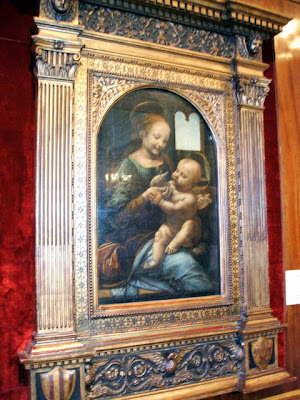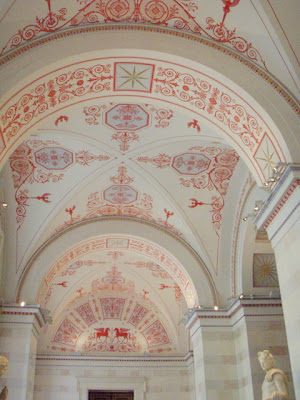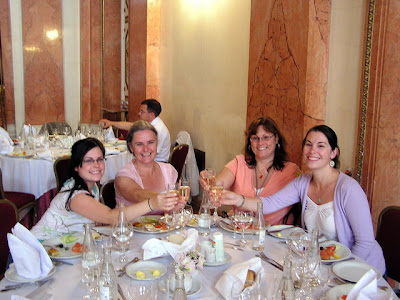Russia, Day One
 Well, I thought I would be able to fit all the remaining trip into one more post, but I'm afraid it's not going to happen. After you read this, stay tuned for one more, where I wrap up the whole trip.
Well, I thought I would be able to fit all the remaining trip into one more post, but I'm afraid it's not going to happen. After you read this, stay tuned for one more, where I wrap up the whole trip.Russia was a busy port for us, especially since we are there for two full days. Unless a guest has a Russian visa, they can't get off the ship without taking a tour. So that's exactly what we did. Day 1: Grand St. Petersburg with Hermitage.
 The Hermitage is Russia's national museum and, along with the Louvre in Paris, is one of the largest in the world. I was lucky enough to visit the Hermitage twice this summer, but I've still only seen a tiny portion of its treasures. It houses more than three million works of art.
The Hermitage is Russia's national museum and, along with the Louvre in Paris, is one of the largest in the world. I was lucky enough to visit the Hermitage twice this summer, but I've still only seen a tiny portion of its treasures. It houses more than three million works of art. The Hermitage is not just a building that holds art. It is also a group of historical buildings that are themselves works of art. Unlike other museums where the exhibits are all neatly arranged, the Hermitage is like one big art exhibit. Everywhere you look there is beauty to be found - floors, ceilings, tables, clocks and so on.
The Hermitage is not just a building that holds art. It is also a group of historical buildings that are themselves works of art. Unlike other museums where the exhibits are all neatly arranged, the Hermitage is like one big art exhibit. Everywhere you look there is beauty to be found - floors, ceilings, tables, clocks and so on.  The most famous building of the Hermitage group is the Winter Palace, one-time home to the Imperial family, the Romanovs.
The most famous building of the Hermitage group is the Winter Palace, one-time home to the Imperial family, the Romanovs.





Painting of Medusa on the floor.

 This is the War Gallery of 1812 in the Winter Palace. It was created to honour military leaders after Emperor Alexander I defeated Napoleon in that year.
This is the War Gallery of 1812 in the Winter Palace. It was created to honour military leaders after Emperor Alexander I defeated Napoleon in that year.
 The ceilings are my absolute favourite feature of the Hermitage.
The ceilings are my absolute favourite feature of the Hermitage.
You can see why.


 Rubens' painting Head of Medusa was a special exhibit both times I visited the museum. Despite its goriness, I find this quite a powerful and fascinating painting. And I am not one for gore.
Rubens' painting Head of Medusa was a special exhibit both times I visited the museum. Despite its goriness, I find this quite a powerful and fascinating painting. And I am not one for gore. These huge decorative vases are everywhere, made from semi-precious stones like malachite (in this photo) and lapis lazuli.
These huge decorative vases are everywhere, made from semi-precious stones like malachite (in this photo) and lapis lazuli.


 The Raphael Loggias are a reproduction of a famous gallery in the Vatican Palace. The originals were produced by students of Raphael, based on his sketches. These masterpieces were recreated in St. Petersburg at the wish of Catherine II. The paintings depict scenes from the Old Testament.
The Raphael Loggias are a reproduction of a famous gallery in the Vatican Palace. The originals were produced by students of Raphael, based on his sketches. These masterpieces were recreated in St. Petersburg at the wish of Catherine II. The paintings depict scenes from the Old Testament.
 Two of the masterpieces in the Hermitage collection are these paintings by Leonardo da Vinci. The first, painted when he was younger is called The Benois Madonna and was painted in 1478.
Two of the masterpieces in the Hermitage collection are these paintings by Leonardo da Vinci. The first, painted when he was younger is called The Benois Madonna and was painted in 1478. The second painting by da Vinci is called The Litta Madonna, painted from 1490-1491. I like this painting because I find you can see the maturity da Vinci gained in the years following the earlier Madonna.
The second painting by da Vinci is called The Litta Madonna, painted from 1490-1491. I like this painting because I find you can see the maturity da Vinci gained in the years following the earlier Madonna. This room is called the Gold Room, however it is not the famous Gold Room. It's just a room that happens to be gold. How flippant I've become (just a room full of gold... no biggie haha). I was lucky enough to visit the famous Gold Room and the Diamond Room earlier in the summer and was sad that we couldn't go again.
This room is called the Gold Room, however it is not the famous Gold Room. It's just a room that happens to be gold. How flippant I've become (just a room full of gold... no biggie haha). I was lucky enough to visit the famous Gold Room and the Diamond Room earlier in the summer and was sad that we couldn't go again.

 I love this sculpture.
I love this sculpture. This is the lovely restaurant where we had lunch.
This is the lovely restaurant where we had lunch. We had caviar, smoked salmon and some other fish dishes to start, followed by cream of mushroom soup, that famous Russian dish Beef Stroganoff and berry pie with espresso. Yummy!
We had caviar, smoked salmon and some other fish dishes to start, followed by cream of mushroom soup, that famous Russian dish Beef Stroganoff and berry pie with espresso. Yummy! Oh yes, and wine.
Oh yes, and wine.
And of course, vodka! When in Russia....

The General Staff Building, as seen from the Winter Palace. I love the General Staff building, it has such a long, gracefully curved shape, and Russians seem to love to paint things in this sunny yellow colour.
 I love Europe for these indulgences. In North America, buildings are mostly just buildings. They don't have such fanciful adornments. But in Europe you walk around straining your neck so you don't miss anything. There are beautiful sculptures and carvings everywhere.
I love Europe for these indulgences. In North America, buildings are mostly just buildings. They don't have such fanciful adornments. But in Europe you walk around straining your neck so you don't miss anything. There are beautiful sculptures and carvings everywhere. We had a little rain, but it didn't get us down.
We had a little rain, but it didn't get us down.
 St. Isaac's Cathedral, which dominates most views of the city. It was one of my first glimpses of St. Petersburg and will be forever burned in my mind as a symbol of that city.
St. Isaac's Cathedral, which dominates most views of the city. It was one of my first glimpses of St. Petersburg and will be forever burned in my mind as a symbol of that city. Inside the cathedral. The interior is completely covered in paintings and mosaics. It also contains pillars made from semi-precious stones like malachite and lapis lazuli.
Inside the cathedral. The interior is completely covered in paintings and mosaics. It also contains pillars made from semi-precious stones like malachite and lapis lazuli. In Russian Orthodox churches there are no pews; everyone stands for the length of the mass, which can run for several hours. In this way, St. Isaac's can hold 14,000 worshippers!!!
In Russian Orthodox churches there are no pews; everyone stands for the length of the mass, which can run for several hours. In this way, St. Isaac's can hold 14,000 worshippers!!!


 This dove is hung from the peak of the dome and represents the Holy Spirit. Under the Soviet government, the cathedral was first abandoned, but later turned into a museum of atheism. The dove was taken down and replaced with a Foucault Pendalum, which demonstrated the rotation of the earth.
This dove is hung from the peak of the dome and represents the Holy Spirit. Under the Soviet government, the cathedral was first abandoned, but later turned into a museum of atheism. The dove was taken down and replaced with a Foucault Pendalum, which demonstrated the rotation of the earth. And that other famous St. Petersburg church, this one built in the traditional Russian style that I love - the Church on Spilled Blood.
And that other famous St. Petersburg church, this one built in the traditional Russian style that I love - the Church on Spilled Blood.
If this post hasn't exhausted your appetite for St. Petersburg and its sights, click here to see more of my wanderings in this beautiful city.





0 Comments:
Post a Comment
<< Home